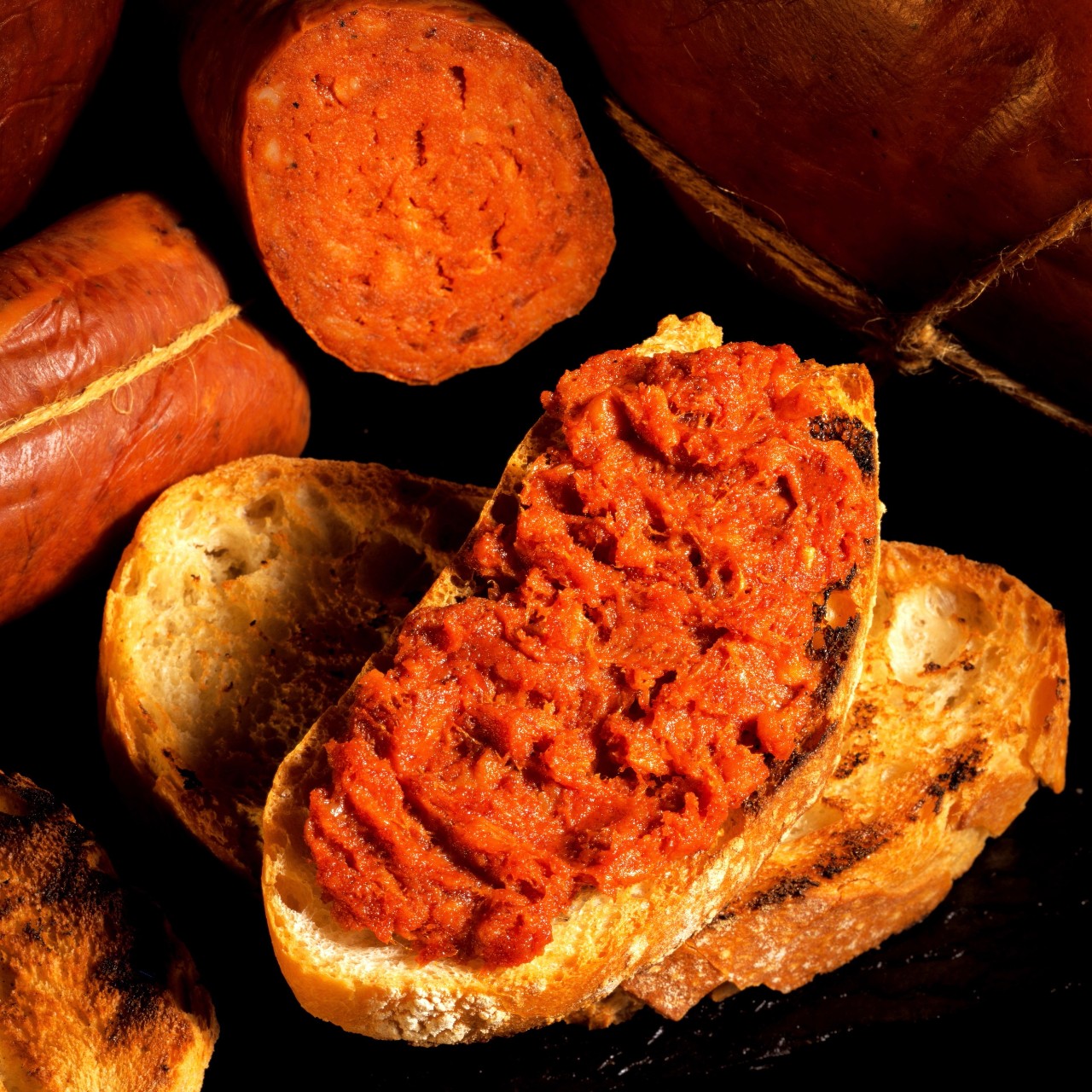by Borja Beneyto “Matoses”, Academic of Spanish Royal Academy of Gastronomy - @matoses
.png.transform/rendition-xs/image_image%20(1).png)

by Borja Beneyto “Matoses”, Academic of Spanish Royal Academy of Gastronomy - @matoses
Savory and luscious, with an addictive acidity and an appealing consumption ritual, sobrasada is the least known sausage and also the one being discovered by the finest palates and chefs around the world for its broad culinary possibilities
It is a raw and cured meat product made from selected pork meats that are minced and seasoned with salt, pimentón, and other spices. It is a very traditional spreadable food in different areas of the Mediterranean; because of its quality and flavor, the version produced in the Balearic Islands stands out. Sausages emerged from the ancient need to preserve and extend the shelf life of meat; the climatic conditions of the islands, especially the influence of temperature and humidity, are not conducive to preserving whole pieces through curing, which is why sobrasada gained notable popularity since its inception.
We must also add its addictive spreadable texture and its unique organoleptic qualities: a delicate mineral depth, varying spicy intensity, and a rich versatility for being consumed independently or accompanied by other sweet and savory ingredients, enhancing its qualities and yielding a splendid gastronomic result. It is coveted by top chefs for adding value to their creations by incorporating its subtle differentiation: balanced aroma, the right proportion of salt, and fat integrated into the whole with elegant spicy nuances.
‘Pimentón’, unique shapes, and consumption possibilities
Our sobrasada has been a culinary treasure for centuries. The production of sobrasada was likely introduced in Mallorca during Roman rule, as it was customary for the Romans to prepare a sausage in pig intestine from a heterogeneous mix of various food types, ground and seasoned.
It is known that during the expansion of the Renaissance in the Mediterranean basin, specifically in Sicily, a technique known as sopressa (meaning ‘pressed,') was practiced for meat preparation. From there, it likely spread to Valencia due to the significant maritime trade of the time, serving as a point for the product's expansion to Mallorca, where it quickly became popular.

We can pinpoint the 18th century as the turning point for sobrasada. At the end of this century, the most significant change in the product's presentation occurred: the red coloration. Pepper, native to the Americas and brought to Europe during the early continental voyages, really made a change as it was the main ingredient for making pimentón in Spain. Pimentón was incorporated into the recipe, giving it the distinctive red color. Although, in line with an enlightened society advancing technologically, manual instruments for chopping meat were replaced by much more effective machines, the meats used are still noble and lean, and production in Majorca is regulated through the Protected Geographical Indication (PGI). The island concentrates the largest volume, while Menorca—generally less fatty and without intense spiciness—has a more artisanal vocation; in the Pitiusas -Eivissa and Formentera-, its production is limited to family consumption. Its recipe has also been maintained for centuries: lean pork—mainly white and Duroc—comprising 30% to 65%, along with fat, pimentón, salt, and pepper. Some producers, particularly in Mallorca, use the distinctive Mallorcan black pig for its tradition and qualities: tenderness, juiciness, and flavor, along with the quality of its fat and high unsaturated fat content; they also add the local pimentón, Tap de Cortí. These ingredients provide qualitative uniqueness but are not mandatory according to the Denomination of Origin.
One product, many versions
Sobrasada comes in various shapes and curing times, from the popular llonganissa (similar to chorizo, up to a kilo and four months of curing) to the bufeta, the bisbe, or the poltrú (bladder, stomach, or caecum, up to twelve kilos and four years of curing). The smaller ones are more tender and fresh, while the larger ones have integrated fat, deep leather notes, and a fantastic texture. In mainland Spain, people usually eat it on bread, but in the Balearic Islands, it’s used in many ways: as a filling for pastries like empanadas and ensaimadas, with fig jam or honey, in stir-fries, as a base for frying, or to add richness to stews. It can be fried, grilled, or eaten raw. And of course, it’s delicious spread on bread with grated tomato, a splash of olive oil, or Mahón-Menorca PDO cheese. Sobrasada isn’t just one of the most traditional and iconic foods of the Balearic Islands; it’s also their best culinary ambassador.

Although its production is not limited to the islands and extends to the rest of the Peninsula, where some producers traditionally dedicated to Iberian pork in Andalusia, Extremadura, and Castile and León make their own versions of the popular sausage. Among the most notable international distributors are Fermín in Castile - León and Can Company in Mallorca. This Mallorcan company is a quality benchmark and also an innovator: Xesc Reina, a master charcutier, has revived forgotten versions of sobrasada such as the one made with porc negre and has also promoted more creative products like sobrasada with curry, blue cheese, and Mahón-Menorca cheese. New uses and approaches for a traditional product whose export grows year by year, from exporting 2.7% in 2021 and 2022 to exporting 4.1% of total sales in 2023. Love (for sobrasada) spreads…